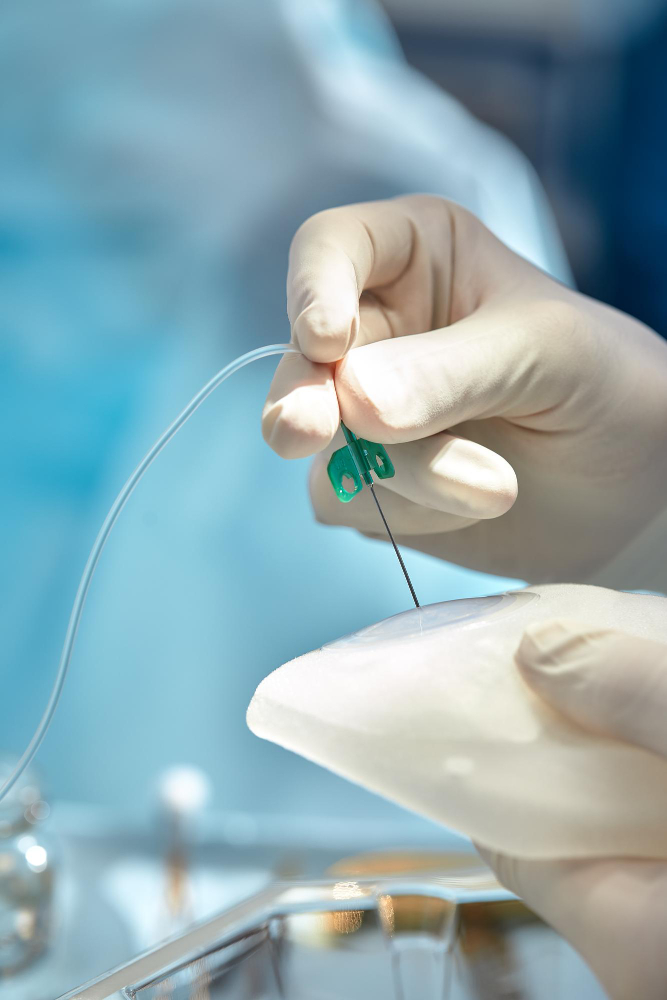

Breast Augmentation
Breast augmentation surgery increases or restores breast size using silicone gel implants, saline implants, or in some cases, fat transfe
Breast Augmentation In Hyderabad
Breast augmentation surgery increases or restores breast size using silicone gel implants, saline implants, or in some cases, fat transfer. One of the most popular and frequently performed aesthetic surgery procedures, breast augmentation has a long and successful track record in satisfying women who wish to enhance, regain or restore balance to their figures.
When should you Consider Breast Augmentation
- If you want a better proportioned or more appealing figure
- If you wish your clothes fit better
- When pregnancy, weight loss or aging has affected the size and shape of your breasts
- To restore symmetry if one of your breasts is smaller than the other
Considerations
Pros
- Augmentation is a long-term solution for achieving an ideal figure.
- You will look better in clothes and swimwear.
- You will have a more youthful-looking figure.
Cons
- Breast implants require monitoring.
- Implants will eventually need to be replaced.
- Normal surgical risks are involved.
These are the three top pros and cons to weigh when considering breast augmentation. If you wish to
focus on what is unique to you, please consult with your aesthetic plastic surgeon.
Frequently Asked Question
Am I a good candidate for breast augmentation?
The following are some common reasons why you may want to consider breast augmentation:
- You believe your breasts are too small for your body.
- You feel self-conscious wearing a swimsuit or form-fitting or low-cut tops.
- Clothes that fit your hips are too large at the bust line.
- Your breasts have become smaller or less firm after you’ve had children.
- Your breasts have become smaller due to weight loss.
- One of your breasts is noticeably smaller than the other. If you are in good health, have a positive attitude and realistic expectations, you are most likely a good candidate for this procedure.
What are my options?
There have never been more choices for breast augmentation. The following options are available, depending on your medical history, body shape and aesthetic goals.
Saline-filled breast implants are filled with sterile saltwater. They may be prefilled at a predetermined size or filled at the time of surgery to allow for minor modifications in implant size. Silicone-filled breast implants are filled with soft, elastic gel and are available in a variety of shapes. All silicone breast implants are pre-filled and may require a longer incision for implant placement.
Autologous fat transfer removes fat through liposuction from an area of your body in which there are abundant fat cells, such as your thighs, abdomen and hips. After a process of preparation and refinement, the fat cells are injected into your breast. This is a procedure being preferred over breast implant augmentation and many ladies who have had implants are replacing their existing implants with their own fat and research has proven it for safety and effective.
Your plastic surgeon might combine any of these breast augmentation options with a breast lift if there is any sagging or drooping of your breasts.
Your anatomy and health profile as well as your personal preferences will help you and your surgeon determine:
- The best type of surgery for you
- Your optimal breast size
- The types of implant and incision location that will best fill your needs.
Your plastic surgeon will examine measure and photograph your breasts for your medical record. Your surgeon will consider:
- The current size and shape of your breasts.
The breast size and shape that you desire. - The quality and quantity of your breast tissue.
- The quality of your skin.
- The placement of your nipples and areolas.
If your breasts are sagging, a breast lift may be recommended in conjunction with breast augmentation. If you are planning to lose a significant amount of weight, be sure to tell your plastic surgeon. The surgeon may recommend that you stabilize your weight before undergoing surgery. If you think that you may want to become pregnant in the future, discuss this with your surgeon.
Pregnancy can alter breast size in an unpredictable way and could affect the long-term results of your breast augmentation. There is no evidence that breast implants will affect pregnancy or your ability to breastfeed, but if you have questions about these matters, you should ask your plastic surgeon.
Breast implants
Following insertion and placement of breast implants, your surgeon will use sutures to close the surgical incisions. Many plastic surgeons will wrap your chest area with a gauze bandage or a surgical compression bra to provide support and assist with healing. Fat transfer Breast augmentation with autologous fat transfer requires two procedures: liposuction and fat injection.
Using liposuction techniques, your plastic surgeon will remove your fat cells from a predetermined location with a cannula, process the fat, and then inject the fat into your breasts. Your liposuction incisions will be closed with sutures, and you will wear compression garments over the liposuction areas and your breasts.
You may be permitted to go home after a short observation period unless you and your plastic surgeon have arranged other plans for your immediate postoperative recovery.
Aftercare and Recovery Your surgeon will discuss how long it will be before you can return to your normal level of activity and work. After surgery, you and your caregiver will receive detailed instructions about your postsurgical care. Immediately after breast augmentation surgery After your breast augmentation procedure, you may be placed in a surgical dressing that can include a support bra or garment.
Breast augmentation surgery stretches the breast tissue and can be painful—especially when implants have been placed under the chest muscle. Typically, the most pain is experienced within the first 48 hours after breast augmentation surgery. Your level of pain will typically decrease each day and maybe effectively treated with various pain medications.
Your breasts may feel tight and sensitive to the touch and your skin may feel warm or itchy. You may experience difficulty raising your arms. Some discoloration and swelling will occur initially, but this will disappear quickly. Most residual swelling will resolve within a month.
About Your Procedure How is a breast augmentation procedure performed?
In breast augmentation using implants, your surgeon makes an incision, lifts the breast tissue, creates a pocket in the chest/breast area and places an implant in the pocket.
An additional option for breast augmentation is autologous fat transfer, a process in which your surgeon removes your own fat, using liposuction, from a fat-yielding body part (such as your abdomen, thighs, or flanks) processes it and then injects it into your breasts. This process has shown promise and one can double the size of their existing breast.
Factors that influence the size and type of breast augmentation recommended for you include:
- Your medical history
- Your goals for breast enhancement
- Your existing body frame and mass
- Your existing breast tissue
- Your preferences are related to size and incision placement.
The goal of your aesthetic plastic surgeon and staff is to help you achieve the best results and to make your surgical experience as easy, safe and comfortable as possible.
Your initial consultation appointment During your initial consultation, you will have the opportunity to discuss your cosmetic goals. Your surgeon will evaluate you as a candidate for breast augmentation and clarify what a breast augmentation can do for you. Understanding your goals and medical condition, both alternative and additional
treatments may be considered.
You should come to the consultation prepared to discuss your complete medical history. This will include information about:- Previous surgeries
- Past and present medical conditions
- Allergies and current medications
- Medical treatments you have received
- Medications you currently take
- Family history of breast cancer
- Current mammogram results
What can I expect on the day of breast augmentation surgery?
Your breast augmentation surgery may be performed in an accredited hospital, free-standing ambulatory facility or office-based surgical suite. Most breast augmentation procedures take at least one to three hours.
- Medications are administered for your comfort during the surgical procedure.
- General anesthesia is commonly used during your breast augmentation procedure, although local anesthesia or intravenous sedation may be desirable in some instances.
- Your surgeon will follow the surgical plan discussed with you before surgery.
- After your procedure is completed, you will be taken into a recovery area, where you will continue to be closely monitored.
What can I expect on the day of breast augmentation surgery?
Your breast augmentation surgery may be performed in an accredited hospital, free-standing ambulatory facility or office-based surgical suite. Most breast augmentation procedures take at least one to three hours.
- Medications are administered for your comfort during the surgical procedure.
- General anesthesia is commonly used during your breast augmentation procedure, although local anesthesia or intravenous sedation may be desirable in some instances.
- Your surgeon will follow the surgical plan discussed with you before surgery.
- After your procedure is completed, you will be taken into a recovery area, where you will continue to be closely monitored.
Recovery time frame after breast augmentation
You should be able to walk without assistance immediately after breast augmentation surgery. It is very important that you walk a few minutes every few hours to reduce the risk of blood clot formation in your legs.
The first week
- For two to five days, you may feel stiff and sore in your chest region.
- Any surgical dressings will be removed within several days. You may be instructed to wear a support bra.
- You will be permitted to shower between one and seven days after surgery.
- If you have external sutures, they will be removed in about a week. If your surgeon used tissue glue or tape, it will fall off on its own in a week or two.
- You may be able to return to work within a few days to a week, depending on the nature of your job.
- You should refrain from lifting, pulling, or pushing anything that causes pain and limit strenuous activity or upper body twisting if this causes discomfort.
Two to six weeks
You should minimize excessive physical activity for at least the first couple of weeks after surgery.
Long-term
Your surgeon will encourage you to schedule routine mammograms at the frequency recommended for your age group. Following breast augmentation, you should continue to perform breast self-examination.
